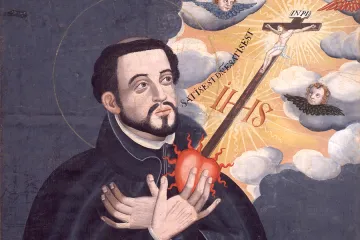CNA Staff, Nov 21, 2024 / 16:50 pm
St. Francis Xavier lived the life of a missionary, baptizing tens of thousands in India and Japan. In death, he continues to give himself to Christ’s Church, as his relics offer pilgrims spiritual consolation in Italy and India.
The saint’s right arm is kept in Italy, while a toe is in India after it was reportedly bitten off by an overzealous pilgrim. But the most intact relic of St. Francis Xavier is his body (nearly whole), which is displayed for veneration every 10 years — in a glass casket to avoid any more toe-related incidents.
At least 12,000 people gathered in the western state of Goa, India, on Thursday for the opening of a decennial exposition of the saint’s partially incorrupt remains. Thursday marked the beginning of a 45-day event where St. Francis Xavier’s relics — normally kept in a casket in the Basilica of Bom Jesus — are displayed at the nearby Se Cathedral for veneration.
The Sacred Relics of St. Francis Xavier was taken into procession from Basilica of Bom Jesus to Se Cathedral Church. The relics of St. Francis Xavier will be kept for venerating for 45 days, till January 5, 2025. pic.twitter.com/bHVsiZiCXP
— DIP Goa (@dip_goa) November 21, 2024
Archbishop Anil Couto of Delhi celebrated the morning Mass at the Basilica of Bom Jesus, joined by more than 400 priests and bishops. Afterward, attendees processed through the streets with the four-century-old glass casket on a carriage to Se Cathedral, less than 1,000 feet away.
Local reports called the exposition an opportunity for religious unity, as many religious groups in India respect the Catholic saint. In anticipation of the decennial exposition, India Prime Minister Narendra Modi called the saint “a symbol of peace,” while locals affectionately call Xavier “Goencho Saib,” meaning “protector of Goa.”
The celebration takes place amid growing violence toward Indian Christians, which has “skyrocketed” according to a 2024 report by U.S. Christian leaders who urged the U.S. State Department to add India to the watchlist for religious freedom violations.
Deeply humbled to seek blessings and stand in the sacred presence of the relic of St. Francis Xavier, a revered figure whose life exemplifies unwavering faith and service to humanity, along with the Hon’ble Governor of Goa Shri @psspillaigov, First Lady, Smt. Ritta S.Pillal,… pic.twitter.com/a8PEeSIfBg
— Mauvin Godinho (@MauvinGodinho) November 21, 2024
To prepare for the exposition, the Goa state government built 33 cottages for pilgrims, with a total capacity of 400 people per day. They expect 8 million to visit the relics during the 45-day period. The last exposition, in 2014, received at least 5.5 million people.
While a group of people traditionally carries the casket on their shoulders, this year’s exposition featured an electric carriage, which an organizer said is being employed to avoid chaos. Goa authorities provided more than 700 police personnel for security and traffic.
The display will continue until Jan. 5. Pilgrims may visit his relics from 7 a.m. to 6 p.m. at the cathedral.
Behind the relic
St. Francis Xavier (1506–1552) was one of the first Jesuits to evangelize vast portions of Asia. He was born into nobility, but his family lost everything when he was young. As a young man, he attended university, where his friend, St. Ignatius of Loyola, encouraged him to give his life to God. Xavier was initially resistant to the call but eventually became a Jesuit priest and missionary.
During his seven years in India, Xavier brought tens of thousands into the Church. While he was there, Xavier lived on rice and water in a hut with a dirt floor, teaching children about God and visiting prisoners and the sick. Xavier later left for Japan, where he instructed the first generation of Japanese Catholic converts. He died of illness on his way to China, at Shangchuan Island. He was buried on the island in his priestly vestments. Xavier’s body was found to be incorrupt after his remains were exhumed within a year after his death on Shangchuan Island in 1552. His body was brought to Malacca first, and then to Goa in 1554. Xavier was canonized in 1622. His feast day is Dec. 3.
Xavier’s remains have been through more than just a change in location. In 1614, his right forearm was removed at the request of Pope Paul V. The relic of his arm has been kept in Rome since, except for a brief visit to Canada, when the arm was flown in a case in an airline seat across Canada.
This was not the first time Xavier had body parts removed. At the first exposition of his body in 1554, a Portuguese woman, Dona Isabel Carom, reportedly bit off one of his toes to keep as a relic. The story goes that the toe began to gush blood. The toe is now kept in a reliquary in Goa.
(Story continues below)
Going back even further, one account recorded that upon finding Xavier’s intact body on the island, Jose Bravo, a Portuguese sailor, cut off a chunk of flesh from Xavier’s knee to prove to his captain that the remains were incorrupt.
Xavier’s body was displayed several times after his death, but the tradition of semi-frequent public exposition began after rumors circulated in 1782 that Xavier’s body had been replaced by another’s remains. The church held a public exposition to address the rumors, beginning a tradition of expositions on special occasions. In recent decades, the tradition has been observed more consistently. This is the 18th exposition of its kind, a part of the saint’s 472-year legacy.






